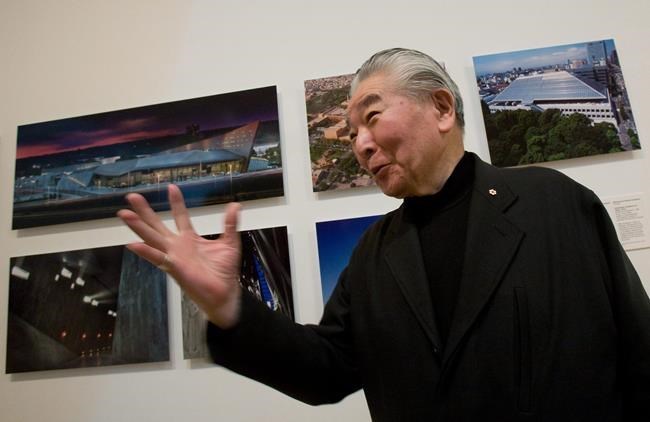TORONTO — Raymond Moriyama, a renowned architect behind the design of some of Canada's most iconic buildings, has died. He was 93.
A spokesperson for the architecture firm he founded said Moriyama died on Friday, but offered few other details.
"The world has lost a visionary architect and (his family members) have lost a treasured loved one," read the statement from Moriyama Teshima Architects.
Moriyama was behind the creation of numerous iconic landmarks both in Canada and abroad, including the National War Museum, Ottawa's City Hall, the Bata Shoe Museum, the Toronto Reference Library, the Ontario Science Centre, the Saudi Arabian National Museum and the Canadian Embassy in Tokyo.
Earlier this year, the firm Moriyama founded called on authorities to preserve the Science Centre building, erected in 1969, urging them to regenerate and use the space. It is slated to be demolished once the centre moves from its current location in east Toronto to a redeveloped Ontario Place on Toronto's waterfront in the coming years.
Moriyama was a highly accomplished architect who won numerous professional accolades over his career, including the Confederation of Canada Medal and the Royal Architectural Institute of Canada Gold Medal. He was named to the highest level of the Order of Canada in 2008 and received honorary degrees from 10 Canadian universities.
Moriyama also served as chancellor of Brock University in St. Catharines, Ont., between 2001 and 2007, an institution where he also designed many of the buildings on campus over the years.
Moriyama was born in Vancouver in 1929. He and his family were dispersed among internment camps the federal government set up for the forcible detention of Japanese Canadians during the Second World War. While Moriyama and other relatives were held at a facility in the British Columbia Interior, his father was sent to one in Ontario. The family's possessions were ultimately seized and sold.
A release from the Canadian War Museum, which named a hall after its designer in 2021, said Moriyama’s first architectural project was a tree house he built as a teen during his time in the camp.
The family relocated to the Ontario city of Hamilton after the war and Moriyama received a Bachelor of Architecture degree from the University of Toronto. He went on to earn a Masters of Architecture degree in Civic and Town Planning from McGill University in Montreal.
In an interview with Maclean's Magazine in 2014, Moriyama said he was inspired to become an architect while bedridden with a burn at the age of four while watching an architect come and go from a Vancouver construction site across the street.
Moriyama founded his own architectural firm in 1958. He later teamed up with Ted Teshima in 1970 to create Moriyama Teshima Architects, which the pair ran until 2003 before ceding to the next generation.
That company paid tribute to its founder in a statement released on Saturday. They said they would make a more comprehensive statement about his legacy in the future.
The firm said its thoughts were with Moriyama's family and loved ones and asked for privacy to allow them to grieve the profound loss.
Toronto Mayor Olivia Chow also paid tribute in a statement, calling Moriyama a "pioneering city builder and architect who designed many of our city’s most treasured landmarks."
"I spent countless hours at the reference library and always left with gratitude through the tranquility created by his design," she added.
This report by The Canadian Press was first published Sept. 2, 2023.
— By Sidhartha Banerjee in Montreal
The Canadian Press




